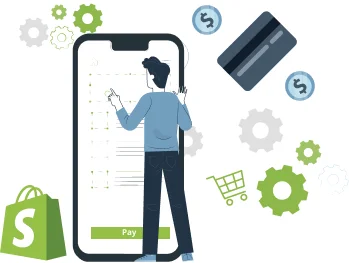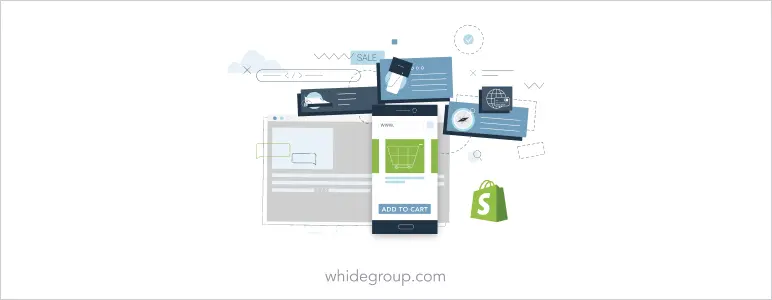Enhancing User Experience:
A Comprehensive Look at Shopify One-Page Checkout

Enhancing User Experience:
A Comprehensive Look at Shopify One-Page Checkout
Share post
Ecommerce checkout experience plays a crucial role in influencing a customer’s decision to complete a purchase. Shopify, known for its modern and flexible approach for building online businesses, completely reimagined their default three page buying process. It now offers a Shopify one-page checkout option that aims to streamline the entire checkout process and simplify the final steps of the purchasing journey improving the conversion.
In this article, we delve into the following intricacies of one-page checkout on Shopify to help you get a full understanding whether or not it provides such a positive impact on shoppers’ buying behavior:
Table of Contents
ToggleOne-page checkout is Shopify’s redesigned checkout flow that is set by default for all Shopify users, except Shopify Plus merchants after the October 2023 update. It streamlines the checkout process by combining all typical steps required to make a purchase on one page. This includes:

Let’s dive into the comprehensive comparison of the one-page and multi-page checkout in the next paragraph. We’ve tried to highlight everything you need to know about the advantages and drawbacks of these options to help you make a proper decision which one of them is worth using in your store in terms of conversion optimization.
Merchants have to understand how one-page checkout is different from three-page checkout – what is the difference in the buying flow, how each design influences customer experience, how it aligns with their customers’ preferences, what are the hidden issues of their implementation, and more. This information allows you to decide on a checkout that will convert customers best.
The standard Shopify checkout is organized into three distinct pages for the customer to complete their purchase. It typically includes the following steps:



The current three-page checkout provides a structured and segmented approach to guiding customers through the purchase process. It has been a familiar and widely used format in online shopping, offering a clear and step-by-step experience for customers to follow when making a purchase for years.
In 2023, Baymard Institute conducted research that shows two reasons related to a process of purchase in the top reasons that influence cart abandonment rate in ecommerce. These are:
When the first reason can be easily eliminated with the setting in the admin dashboard, the second one is easily fixed by the new redesigned checkout leading to a more convenient shopping experience.

The checkout where all steps are presented on the one page, provides a simplified process and more user-friendly experience. The main pros that differ it from the old version are:
Understanding these distinctions can help businesses tailor the purchasing flow to better suit their customers’ preferences and enhance overall shopping experiences.
The specific features of one-page checkout may vary depending on your theme and any additional apps or customizations you have. However, there are several common key features that contribute to a smooth and efficient purchasing process for customers. These are:
These features collectively contribute to a simplified, user-friendly, and efficient buying procedure, improving user experience for customers and boosting conversion rates for businesses.
One-page checkout is designed to offer significant benefits for both businesses and customers. In this chapter we’ll explore its ins and outs, and look at how it speeds up transactions and lowers cart abandonment rates, revealing its strengths, weaknesses and popularity.
The updated checkout allows merchants to enhance user experience, improve conversion rates, and offer customization options, which makes it a compelling choice for many Shopify merchants looking to optimize their conversions. Its main benefits are:

While the single-page checkout for Shopify offers several advantages, it’s important to consider some potential drawbacks, including:
Businesses should properly consider the benefits of a buying process performed on one page against its drawbacks before updating checkout experience for their customers. In addition to that, merchants should take into account the following factors:
As you can see, nothing is perfect. As every ecommerce business has its own vision, strategy, and target audience, the decision on the type of checkout to use has to be thoroughly considered. Take your time to make a deep analysis, implement A/B tests, review customers behavior heatmaps, and more to decide on the suitable checkout for your Shopify store.
Shopify merchants have been waiting for this layout update for a long period of time. However, some businesses still use checkout apps from the Shopify app store to customize their checkout page – add extra features like customizable banners, FOMO triggers, rules for shipping and payment options, etc.
Check out the list of Shopify alternatives carefully selected by our Shopify experts.
Qikify Checkout Customizer offers a comprehensive set of features to enhance the checkout on Shopify. With nine different checkout add-ons, free custom branding, and the ability to customize payment and delivery methods, it provides advanced shopping experience. Shopify Plus store owners can utilize Custom Fields to gather customer information. At the same time, features like Product Offers and auto discounts facilitate effective upselling and cross-selling. The tool aims to streamline the buying process, reduce cart abandonment, and includes additional customization options such as banners, reward bars, testimonials, and more. Importantly, the customization options are available for all Shopify plans.

Key features:
Instant Checkout – Buy button app adds a dynamic “Buy Now” button on the product page. This button allows customers to bypass the shopping cart, reducing the number of checkout steps. It works almost like a one-click checkout guiding customers to completing the purchase without interruptions. This app simplifies the buying process and ultimately increases conversion rates.

Key features:
Checkout Blocks app allows you to modify checkout and thank you pages on Shopify stores. It is a highly flexible application that provides multiple customization options. It is a checkout editor that allows you to modify colors and layout, add upsells in the information and cart sections. Merchants can also add custom fields, banners, and dynamic notification messages. You can also enable and disable specific payment and shipping options – everything you need to make your customers’ buying journey more convenient and efficient. You have to upgrade to Shopify Plus to use this app.

Key features:
Be Sure Checkout Rules is an app that allows you to adjust the display and order of shipping and payment methods. Merchants can implement various conditions such as cart total, weight, address, items in the cart, and tags to reorder, rename, or hide these methods. For example, you can set a default pre-selected method, hide express payment options like PayPal and Shop Pay, and strategically position Collection/Store Pickup. It is easy to implement restrictions, such as blocking checkout for post office box addresses or modifying the names of shipping and payment methods. This provides a flexible and personalized user experience

Key features:
Before downloading third-party apps to customize your store, it’s crucial to pinpoint your requirements. Identify the aspects of your business that could benefit from added functionality.
After compiling a list of potential apps, thoroughly examine their reviews and ratings. Take note of comments highlighting specific features or concerns that align with your business requirements. Take advantage of free trials or basic versions with limited features to evaluate whether an app meets your expectations before committing to a subscription.
Selecting the right apps for your Shopify store is a crucial decision that can significantly impact its performance and customer experience.
As we mentioned earlier, the default checkout layout is now set to one-page checkout on your Shopify store if you are using any Shopify plan except Shopify Plus plan. Some merchants may choose to switch between one-page checkout and multi-page checkout depending on their business objectives and preferences. The option to change Shopify checkout layout is available in your Shopify dashboard.
So, if you want to disable One-Page checkout in Shopify, here is the tutorial:
1 Step: Log in to your Shopify admin dashboard.
2 Step: Go to Online Store > Themes.
3 Step: Click Customize and choose Theme settings.
4 Step: Go to the Checkout layout section.
5 Step: Set “Three-page checkout” from your Shopify admin dashboard as the default simply clicking to the corresponding title.
6 Step: Click “Save” to apply changes.

Take your time, consider all benefits and drawbacks of two Shopify checkout designs and consider which one will serve your business best before making any changes.
It’s a fact that checkout – its layout, flow, clarity and convenience – plays one of the important roles in converting website visitors into buyers. As every ecommerce business is different, there is no universal checkout solution. Recent research states that one-page checkout shows good results in reducing cart abandonment rate and improving conversion compared to multi-page checkout. It presents a modern approach to the final stage of the buyer journey. While it offers numerous benefits such as improved user experience and faster processing, it may pose challenges in analytics tracking. Merchants should carefully weigh the pros and cons, considering whether it is worth using compared to the classic multi-page checkout, or if it is necessary to implement alternative checkout app to ensure an optimal experience for their customers.
If you are uncertain about which checkout experience to follow in your store, contact us and Whidegroup specialists will provide you valuable insights based on the deep analysis of your ecommerce business. Through consultation, we will help you to determine immediate goals and explore ways to achieve them, whether it involves changing the checkout process or making deeper adjustments to the store’s overall functionality and user experience.
Share This Article

 Shopify Website Development Cost in 2024: An In-Depth Breakdown of How Whidegroup...
Shopify Website Development Cost in 2024: An In-Depth Breakdown of How Whidegroup...